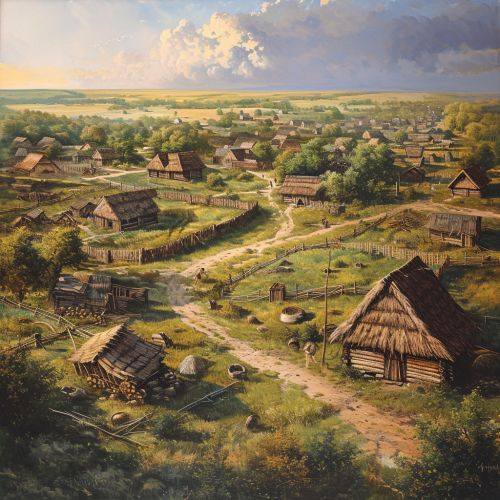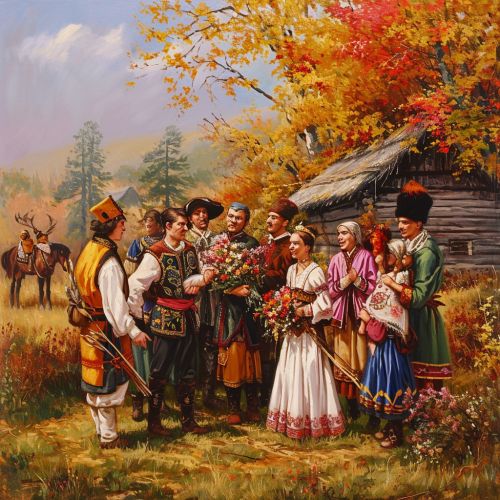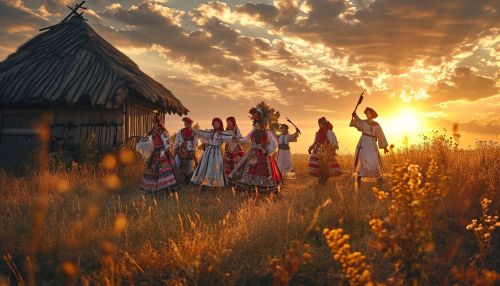Slavic peoples
Origins and Early History
The Slavic peoples are an Indo-European ethno-linguistic group who are native to Eastern Europe, the Balkans, Central Europe, and North Asia. They share a common ancestry, culture, history, and are native speakers of the Slavic language family. The Slavs emerged as a distinct group in the historical region of Eastern Europe from the indigenous Proto-Slavic population around the 6th century AD.


The Proto-Slavic, the supposed ancestor language of all Slavic languages, is believed to have been spoken during the Early Middle Ages by the ancestors of the Slavs. The Proto-Slavic language evolved from the Proto-Balto-Slavic language, a language of the Indo-European family, which is believed to have existed from the 2nd millennium to the 1st millennium BC.
Expansion and Migration
During the 6th century, Slavs spread westwards from their original homeland in Eastern Europe, and simultaneously southwards into the Balkans. By the early 6th century, Slavs had settled the Eastern Alps regions. They migrated in one of the largest and most rapid series of migrations in the history of Europe. The first wave of Slavic migration, known as the Wielbark migration, led to the integration of Slavic groups with the Goths and other Germanic peoples.
Slavic States and Empires
Throughout the Middle Ages and into the modern era, various Slavic states and empires emerged, contributing significantly to the political, cultural, and economic landscape of Europe. Some of the most notable include the Kievan Rus, the Grand Duchy of Moscow, the Kingdom of Poland, the Czechoslovak Republic, and the Socialist Federal Republic of Yugoslavia.
Culture and Society
Slavic cultures are diverse and varied, reflecting the wide geographical range of Slavic peoples. However, there are certain cultural elements that are commonly found among many Slavic societies. These include folklore, mythology, music, cuisine, traditional clothing, and social customs. Slavic cultures have also been influenced by a variety of external cultures and societies, including the Byzantine Empire, the Ottoman Empire, and various Germanic, Hungarian, Romanian, and Baltic tribes.


Religion
The Slavic peoples have a complex religious history and tradition. Early Slavs were predominantly pagan, with a pantheon of gods and spirits which was shared across different Slavic tribes. With the advent of Christianity, many Slavs were converted to the new religion, often through the efforts of missionaries such as Saints Cyril and Methodius. Today, the majority of Slavs are Orthodox Christians, followed by Roman Catholics and a minority of Protestants and Muslims.
Language
The Slavic languages, also known as the Slavonic languages, are a group of closely related languages of the Slavic peoples and a subgroup of the larger Indo-European language family. They are divided into three subgroups: East, West, and South, which together include more than 20 languages. Slavic languages are spoken by more than 315 million people worldwide, primarily in Eastern Europe, the Balkans, Central Europe and North Asia.
Modern Slavic Nations
Today, Slavic peoples are recognized as nationalities within many countries of Eastern Europe, including Russia, Poland, the Czech Republic, Slovakia, Ukraine, Belarus, Bulgaria, Serbia, Croatia, Slovenia, Bosnia and Herzegovina, Macedonia, and Montenegro. Despite the political, social, and economic changes that these countries have undergone in the past century, the Slavic identity remains a significant part of their cultural heritage.
